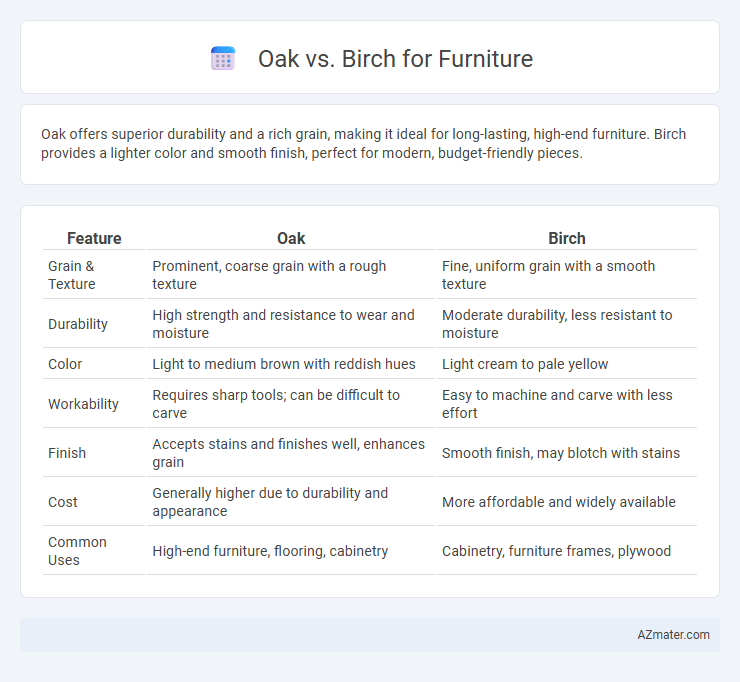Oak offers superior durability and a rich grain, making it ideal for long-lasting, high-end furniture. Birch provides a lighter color and smooth finish, perfect for modern, budget-friendly pieces.
Table of Comparison
| Feature | Oak | Birch |
|---|---|---|
| Grain & Texture | Prominent, coarse grain with a rough texture | Fine, uniform grain with a smooth texture |
| Durability | High strength and resistance to wear and moisture | Moderate durability, less resistant to moisture |
| Color | Light to medium brown with reddish hues | Light cream to pale yellow |
| Workability | Requires sharp tools; can be difficult to carve | Easy to machine and carve with less effort |
| Finish | Accepts stains and finishes well, enhances grain | Smooth finish, may blotch with stains |
| Cost | Generally higher due to durability and appearance | More affordable and widely available |
| Common Uses | High-end furniture, flooring, cabinetry | Cabinetry, furniture frames, plywood |
Introduction: Oak vs Birch Furniture Comparison
Oak furniture boasts exceptional durability and a rich grain pattern, making it ideal for long-lasting, high-quality pieces, while birch offers a lighter appearance with smooth, fine texture suited for modern, minimalist designs. Oak's natural resistance to wear and moisture contributes to its popularity in traditional and rustic settings, whereas birch's affordability and ease of staining provide versatility for various styles. Evaluating factors such as hardness, grain aesthetics, and cost helps determine the best choice for specific furniture needs.
Understanding Oak Wood Characteristics
Oak wood is renowned for its exceptional strength, durability, and prominent grain patterns, making it a top choice for furniture that withstands heavy use. Its high tannin content provides natural resistance to pests and decay, enhancing longevity in oak furniture pieces. Compared to birch, oak offers a heavier and more robust structure with a slightly coarse texture that ages gracefully, adding character to high-quality furniture designs.
Key Features of Birch Wood
Birch wood is renowned for its fine, even texture and pale color, making it an excellent choice for furniture that requires a smooth, uniform appearance. Its high strength and resistance to warping contribute to durable, long-lasting pieces, while its moderate hardness allows for intricate carving and detailed woodworking. Birch also takes stain well, enabling versatile finishes that enhance its natural grain and complement diverse design styles.
Durability: Oak vs Birch
Oak is renowned for its exceptional durability, characterized by a high Janka hardness rating of approximately 1,290, making it resistant to dents and scratches, ideal for heavy-use furniture. Birch, with a Janka hardness around 1,260, offers good durability but is slightly softer compared to oak, which might show wear more quickly under heavy use. Both woods provide sturdy options, but oak's denser grain and higher resistance to impacts make it superior for long-lasting furniture pieces.
Aesthetic Differences: Grain, Color, and Texture
Oak furniture showcases a prominent, coarse grain with a warm, golden to medium brown color that deepens over time, creating a classic and robust look. Birch offers a finer, more uniform grain pattern with a lighter, creamy to pale yellow hue that lends a sleek, modern aesthetic. Oak's texture feels rougher and more textured, enhancing rustic or traditional designs, while birch has a smoother, softer surface ideal for contemporary and minimalist furniture styles.
Workability and Crafting Ease
Oak wood offers excellent workability due to its hardness and coarse grain, providing durability and a smooth finish when properly sanded and treated, making it ideal for heavy-duty furniture. Birch wood is softer and has a fine, even grain that enhances crafting ease, allowing for precise cuts and detailed designs with minimal tool wear, preferred for delicate or decorative pieces. Both woods respond well to staining and finishing, but birch's consistent texture typically makes it more forgiving and easier for intricate joinery and carving.
Cost and Availability
Oak furniture tends to be more expensive due to its density, durability, and long-standing popularity in traditional and modern designs. Birch furniture is generally more affordable, as birch trees grow faster and are more readily available in many regions, making the wood easier to source. The availability of oak can be limited by slower growth rates and higher demand, while birch offers a cost-effective alternative with good strength and a lighter appearance.
Ideal Furniture Types for Oak
Oak wood is highly durable and dense, making it ideal for heavy-use furniture such as dining tables, cabinets, and dressers. Its prominent grain pattern and natural strength provide both aesthetic appeal and long-lasting support for chairs and bed frames. Oak's resistance to wear and moisture also makes it suitable for furniture in high-traffic areas and kitchens.
Best Uses for Birch in Furniture
Birch wood excels in furniture making due to its fine grain, light color, and smooth finish, making it ideal for modern and Scandinavian-style pieces. Its durability and resistance to wear make birch perfect for chairs, cabinets, and tables that require both strength and aesthetic appeal. Birch's affordability compared to hardwoods like oak makes it a popular choice for budget-friendly, high-quality furniture.
Final Verdict: Choosing Between Oak and Birch
Oak offers superior durability and a distinct grain pattern, making it ideal for furniture that requires long-lasting strength and a classic aesthetic. Birch provides a smooth, light finish with good workability, suitable for modern and budget-conscious designs. Ultimately, selecting between oak and birch depends on the desired balance between robustness and affordable versatility for your furniture project.

Infographic: Oak vs Birch for Furniture
 azmater.com
azmater.com